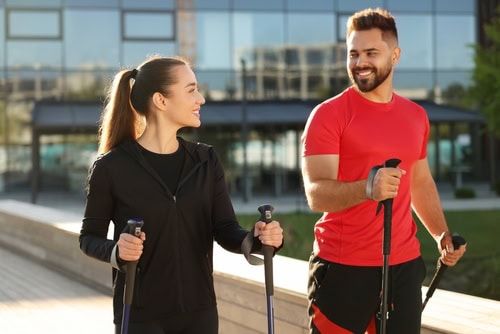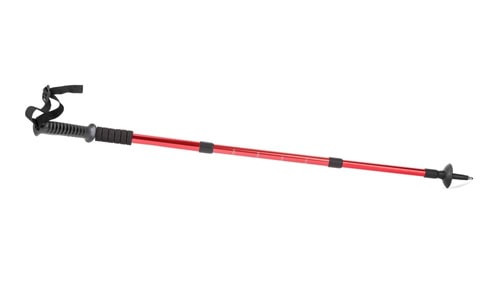
Walking is something we’ve been doing since we were toddlers, but what if there was a way to make your daily stroll work twice as hard for you? Welcome to Nordic Walking, a simple yet powerful exercise that could be the game-changer you’ve been looking for in your weight loss journey.
According to Dr. Rajeev Sharma, Vice President Medical Affairs at TATA 1mg, “In today’s sedentary lifestyle, simply standing up and moving for five minutes after every 55 minutes of sitting can help keep your metabolism active.”
When most people think about losing weight, they often picture intense gym workouts, endless treadmill sessions, and strict calorie tracking. But what if I told you that you could burn a lot of calories, tone your whole body, and enjoy the outdoors, all by using a pair of walking poles?
In this article, we’ll explore how Nordic walking works, why it’s an effective weight loss method, and how to get started, even if you haven’t exercised in a long time.
What is Nordic Walking Exactly?
Imagine yourself walking quickly while holding poles similar to those used in skiing. That’s essentially what Nordic walking is. It began in the 1930s as a training method for Finnish cross-country skiers to maintain fitness during the off-season. Over time, it evolved into its own form of exercise.
Unlike normal walking, which primarily uses your legs, Nordic walking engages your arms, shoulders, chest, and core muscles as well. The poles serve more than just balance; they are actively used to push your body forward, somewhat like paddling as you walk. This transforms a regular walk into a full-body, low-impact workout.
Here’s the interesting part: even though you’re working more muscles, Nordic walking feels less strenuous because the poles help distribute your weight and momentum. This allows you to exert more effort, burn extra calories, and still experience less tiredness compared to conventional exercise.
The Weight Loss Science Behind Nordic Walking

If your main goal is shedding pounds, Nordic walking is worth serious consideration. Let’s break down why:
1. Higher Calorie Burn Than Regular Walking
Studies show that Nordic walking can burn 20–46% more calories compared to normal walking at the same speed. Why? Because your upper body is working just as hard as your legs. You’re turning a simple cardio exercise into a strength-plus-cardio hybrid without even realizing it.
For example, a 70.3 kilograms person walking at a brisk pace might burn around 250 calories in 30 minutes. Add poles into the mix, and that number can jump to over 350 calories. Over time, that’s a huge difference.
2. Full-Body Muscle Engagement
Nordic walking works about 90% of your muscles. While walking usually only targets your lower body, this technique recruits your arms, shoulders, chest, back, and abs. More muscle engagement means a higher calorie demand, which translates to faster fat loss and improved muscle tone.
3. Low-Impact, High-Efficiency Exercise
Unlike running, which can be tough on your knees and joints, Nordic walking distributes pressure more evenly. This makes it an excellent choice for people who are overweight, have joint pain, or are new to exercise. You can sustain longer sessions without the wear and tear, allowing for more consistent calorie burning.
4. Boosts Cardiovascular Health
Weight loss isn’t just about burning calories; it’s about improving your metabolic engine. Nordic walking increases your heart rate more than normal walking (often by 10–15 beats per minute), meaning your heart and lungs get stronger. A stronger cardiovascular system helps you burn fat more efficiently, even when you’re at rest.
5. Sustainable and Enjoyable
Let’s face it: the best workout for weight loss is the one you’ll actually stick with. Nordic walking doesn’t feel like punishment. It’s fun, it can be social, and it allows you to explore nature or your local neighborhood. The enjoyment factor makes it easier to stay consistent, which is the real key to long-term weight loss.
Why Nordic Walking Beats Other Workouts for Weight Loss

Now you might be wondering: why not just jog or cycle instead? While those activities are also great, Nordic walking offers some unique advantages:
- Less strain than running – perfect if you’re overweight, recovering from injury, or just don’t like the pounding impact of jogging.
- More muscle activation than cycling – your upper body and core stay engaged throughout, giving you more balanced fitness results.
- Accessibility – unlike gym equipment or fancy gear, all you need are poles (which are affordable) and a good pair of shoes.
- Scalability – whether you’re a beginner walking slowly or a fitness buff powering up hills, Nordic walking adjusts to your level.
It’s essentially the “goldilocks workout”: not too hard, not too easy, but just right for effective, sustainable fat loss.
Choosing the Right Equipment

The key to successful Nordic walking lies in having the right poles. Here’s what you need to know:
-Pole Length: The general rule is to multiply your height in centimeters by 0.68. When holding the pole with the tip on the ground, your elbow should form a 90-degree angle
| Height | Recommended Pole Length |
| 4’9″ – 4’11” 100 cm | 100 cm |
| 4’11” – 5’3″ | 105 cm |
| 5’3″ – 5’5″ | 110 cm |
| 5’5″ – 5’8″ | 115 cm |
| 5’8″ – 5’11” | 120 cm |
| 5’11” – 6’2″ | 125 cm |
| 6’2″ – 6’4″ | 130 cm |
-Material: Choose poles made of carbon fiber or a carbon-fiberglass blend. They’re lighter,
reduce vibrations, and are more comfortable for extended use. Aim for at least 50% carbon
content, or 80% if you plan to practice regularly.
-Handles and Straps: Look for ergonomic handles made of cork or rubber that absorb
perspiration. The wrist straps (gauntlets) are crucial for proper technique; simple wrist straps
won’t do.
How to Start Nordic Walking for Weight Loss
Getting started is surprisingly simple. Here’s a step-by-step guide:
1. Get the Right Poles
Don’t just grab trekking poles. Nordic walking poles are slightly different; they have specialized straps that help you push off effectively. Adjustable poles are best, so you can tailor them to your height.
2. Learn the Technique
The basic motion is natural:
- Plant the pole diagonally behind you.
- Push off as your opposite foot moves forward.
- Keep your arms relaxed but engaged.
- Walk with a rhythm, letting the poles guide your stride.
- It might feel awkward at first, but within 10 minutes, it becomes second nature.
3. Start Slow and Build Up
If you’re new to exercise, begin with 15–20 minutes a few times a week. Gradually increase your time and intensity. Aim for 30–60 minutes, 3–5 times a week for optimal weight loss.
4. Mix Up Your Routes
Variety keeps things interesting. Try different parks, trails, or urban routes. Hills add intensity and help you burn even more calories.
5. Track Your Progress
Use a fitness watch, app, or even just a notebook. Tracking your sessions and calories burned can motivate you to keep going.
Tips to Maximize Weight Loss with Nordic Walking
-Combine with healthy eating – Exercise alone won’t do the trick. Pair your walking with balanced nutrition.
-Add intervals – Speed up for 1–2 minutes, then slow down. This interval style boosts calorie burn.
-Walk with friends – Social accountability makes it easier to stick with your routine.
-Focus on posture – Engage your core and keep your chest open for the best results.
-Stay consistent – Even shorter walks done regularly are better than occasional long ones.
Common Mistakes to Avoid
- Don’t swing the same arm and leg together (this is called “ambling”)
- Avoid planting poles too far in front of you
- Don’t grip the handles too tightly
- Keep your back straight and look ahead
The Mind-Body Advantage
In addition to clear physical benefits, Nordic walking provides a mental health uplift that can indirectly support weight loss. Spending time outside helps lower stress levels, and the rhythmic movement using the poles can have a calming, almost meditative effect. Reduced stress leads to fewer cortisol surges, which are associated with abdominal weight gain.
Moreover, when exercise is enjoyable rather than a chore, you’re more inclined to maintain it over time. This ongoing commitment is what transforms temporary calorie burning into sustainable weight control.
Final Thoughts: Achieve Better Fitness by Walking
Nordic walking may not be as flashy as high-intensity interval training or as popular as hot yoga, but it’s a hidden treasure when it comes to losing weight. It burns more calories than regular walking, tones your whole body, and is easy on your joints. Most importantly, it offers a sustainable and enjoyable way to stay active.
If you’ve had trouble finding an exercise you enjoy, give Nordic walking a shot. Grab your poles, head outdoors, and let the rhythm guide you. You’ll be surprised at how quickly you start shedding pounds, not just around your waist, but also the burdens of stress, tiredness, and self-doubt.
Sometimes, the simplest methods are the most effective. With Nordic walking, all it takes is a single step, a pole plant, and some consistency to embark on a journey toward lasting weight loss and vibrant health.
Quick FAQs About Nordic Walking for Weight Loss
1. Is Nordic walking good for beginners?
Yes, it’s easy to learn and suitable for all fitness levels.
2. How many calories does it burn?
Around 300–400 calories per hour for a 70 kg (155 lb) person.
3. Do I need special poles?
Yes, Nordic poles have straps that activate the upper body, unlike trekking poles.
4. Is it easier on joints than running?
Definitely. It’s low-impact, making it gentler on knees and back.
5. How often should I do it to lose weight?
Aim for 30–60 minutes, 3–5 times per week.
6. Is it only for older adults?
No, people of all ages and fitness levels enjoy Nordic walking.
Recommended Reads
6 Best Japanese Foods for a Happier Gut
Japanese Walking Technique: Expert-Approved Method for Naturally Losing Belly Fat
(The article is written by Mantasha, Executive, Clinical Health & Content, and reviewed by Monalisa Deka, Senior Health Content Editor)